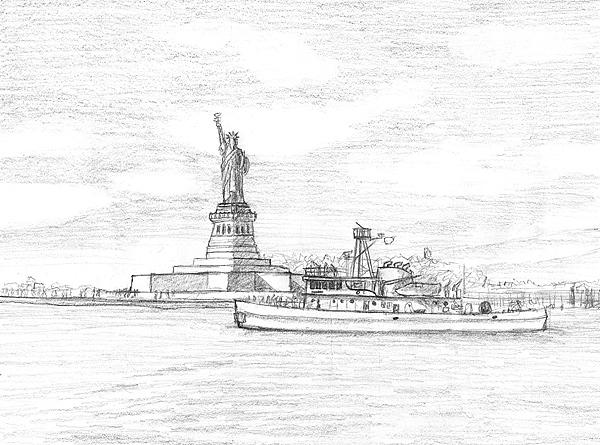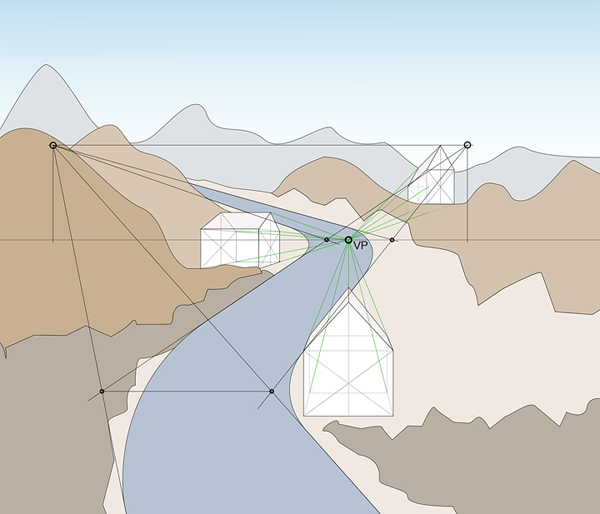how to draw a landscape
How to draw a landscape picture
In this tutorial I will give a few tips, tricks and links to the topic of drawing landscapes. Of course, there is no special landscape drawing patent recipe and it is as always "look well and not be deceived by your own senses" ... oh yes, besides, exercise, exercise, exercise ;-).
This applies at least to the purely technical part, but landscape images are more multifaceted. Therefore, the tips and tricks, which I have written down here, can certainly help you to learn how to draw a landscape pictures.
Landscape drawing
As a landscape in the sense of a landscape drawing we understand representations of the environment created by nature or man. Typical landscape drawings depict natural landscapes, mountains, cities, factory landscapes, seascape, park landscapes et cetera. In contrast to a still life - to name just one example - a landscape drawing shows a much larger section of the environment.

How to draw landscapes
Drawing landscapes
A challenge when drawing a landscape is, on the one hand, that the objects (trees, meadows, buildings, mountains) can not be drawn with every detail. That would take much too long. Everything has to be simplified. Thus, for example, the leaves of trees are only intuitively drawn, just as the grass of the meadows, the trees of the woods, the windows of skyscrapers, and so on.
In the pictures below you can see how a forest, a tree, high-rise buildings and meadows can easily be illustrated.
.jpg)
.jpg)
.jpg)
Examples simplified illustration
The second difficulty you have to master when drawing a landscape is the "natural forces". For example, while you are drawing, the wind could blow the leaves and branches of trees in a different direction. Or the sun is in a different place after some time and lets the shadows fall in another direction. All these things change the landscape you draw and your drawing no longer matches reality.
Design of landscape drawings
If you want to draw landscapes, you have a variety of possibilities to realise the picture. First you have to decide which landscape you want to draw and which area you want to show in your picture. Do you want to draw a beach picture, a mountain landscape or a city? There are infinitely many possibilities open.
.jpg)
.jpg)
.jpg)
Drawing landscapes: examples of different landscapes (beach, city and field)
If you have chosen a landscape, another important consideration is the time of the day, the time of the year, and the weather. The same landscape can finally look completely different under different weather conditions. In the winter everything could be covered by a snow, while in summer everything is green and blooming. You can draw a scene at night, by day or during sunrise, for example.
.jpg)
Draw landscapes: create moods through times, seasons and weather
Depending on the time of the day, the weather and the time of the year you decide, the landscape drawing can create a completely different feeling for the viewer. A landscape in the rainy weather can, for example, create rather melancholic feelings. When everything is covered by snow, everything seems more peaceful. A landscape drawing with flowering meadows and trees with leaves usually looks friendly and amusing.
.jpg)
Example of a landscape drawing
But there is more to consider when drawing a landscape. One should consider exactly where the horizon should be positioned in the drawing. The horizon is the limit at which the sky and earth meet. Depending on where you lay the horizon, you can either see more from the sky or more from the ground on the drawing. Experiment a bit around, make a few sketches and designs to find the best placement of the horizon for your landscape picture.
.jpg)
Drawing landscapes: Different positioning of the horizon in a landscape drawing
Perspective methods in landscape drawings
And there are still more tricks how to draw landscapes better (now, however, it will be somewhat technical). An important aspect of a landscape is the perspective.
All objects are smaller the further they are away from us. This effect of the distance is of course very strong in the landscape, as we look far into the distance. The decrease in size of the objects can be illustrated relatively easily with a drawing aid: The perspective with vanishing points.
Perhaps you may have already heard of perspective drawing with the help of vanishing points. The principle means that all objects become smaller along vanishing lines. These lines all converge at a point that lies on the horizon. It can be compared with the rays of the sun, which radiate from the sun into all corners and angles of the image. Only the vanishing lines run (at least mentally) in the other direction.
In the picture below you can see an illustration which show a landscape drawn with the help of a simple one-point perspective.

Perspective drawing
The picture above shows only a simple form of perspective drawing. There are other variants with several escape points. But I will not go into it further, but you will get a few links, under which you will find a very detailed guide with tips and tricks for perspective drawing:
- Drawing in Perspective
- One-point Perspective
- Two-point Perspective
- Three-point Perspective
A few tips for drawing landscapes
Try to place a few eyecatchers on your landscaping. This means objects that fall into the eye and make the drawing more interesting.
Make sure that your landscape does not only contain horizontal lines or structures, because that is boring. Also try to get picture objects on your picture, which are vertical like trees.
In addition, these rules apply not only to drawing, but also to painting landscapes.
Here is a summary of everything you need to consider when drawing or painting a landscape:
- Choice of a landscape / surroundings (city, nature, meadow, mountains, sea ...)
- Search and choice of eyecatchers and interesting objects and structures
- Position the horizon
- Choice of the image detail / total composition
- Choice of a season
- Choice of weather conditions
- Draw it!
how to draw a landscape
Source: https://www.art-class.net/06-tutorials/landscapes/landscape.php
Posted by: miyashirouplarn.blogspot.com

0 Response to "how to draw a landscape"
Post a Comment